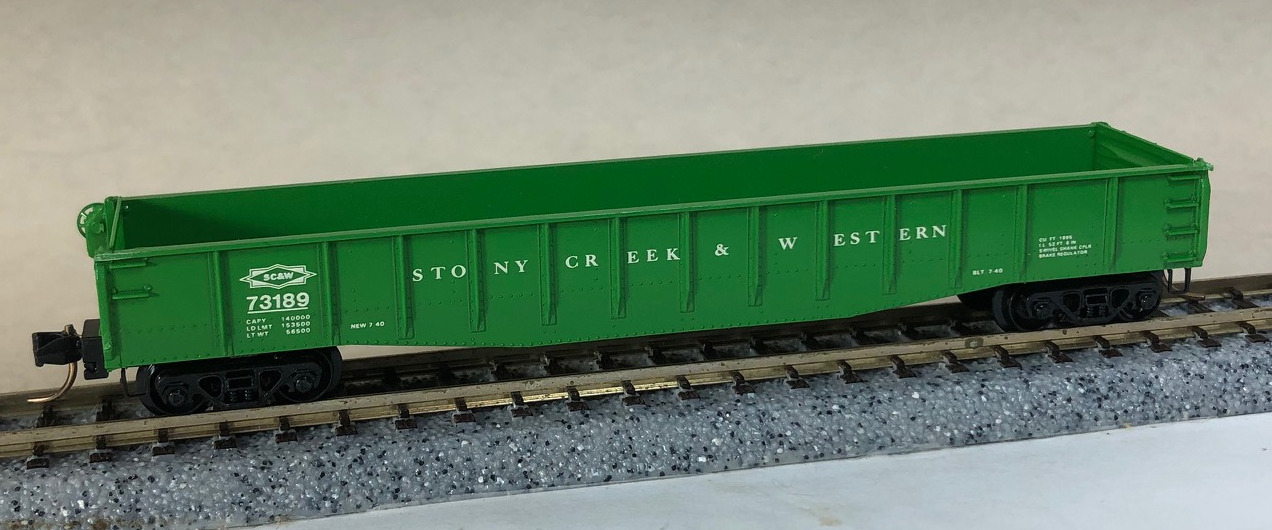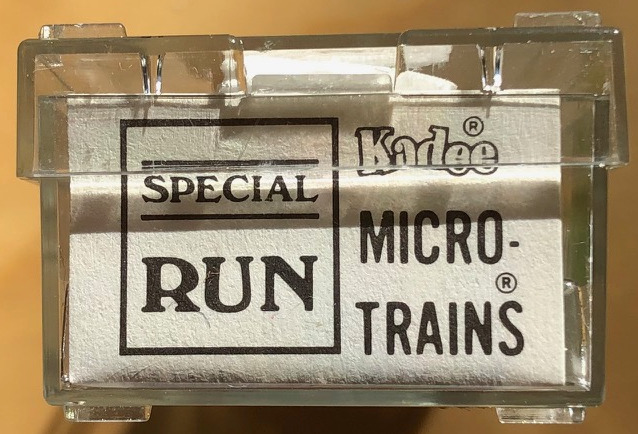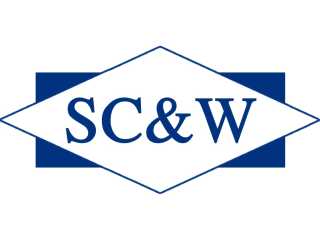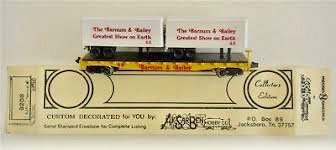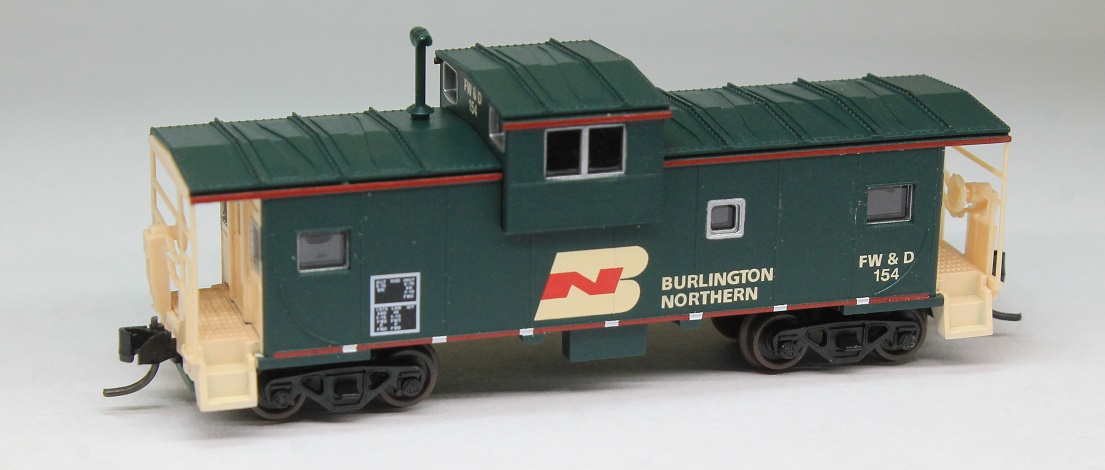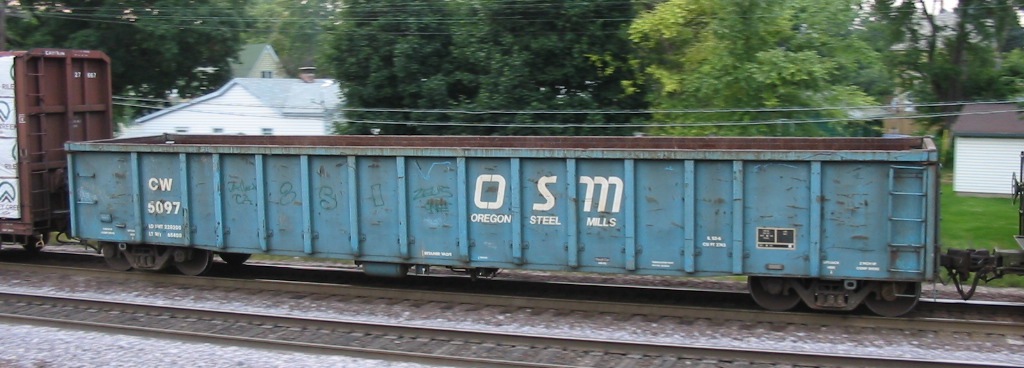Model Information: This model is one of Micro-Trains' earliest releases. It was first produced in 1975 with Dimensional Data, and the following year in several different paint schemes. It models a 50 foot steel gondola with a fishbelly and drop-ends. Note that many 3rd party loads designed for MTL's fix-end gondola will not fit in this model. What is cool is that the ends can actually be dropped! This feature makes this model unique among N Scale gondola toolings.
This model is equipped with National B-1 Trucks w. short extension (MTL 003 02 151 (1195)) and one end and w. medium extension on the other end.
This model is equipped with National B-1 Trucks w. short extension (MTL 003 02 151 (1195)) and one end and w. medium extension on the other end.
Prototype History: In US railroad terminology, a gondola is an open-topped rail vehicle used for transporting loose bulk materials. Because of their low side walls, gondolas are also suitable for the carriage of such high-density cargoes as steel plates, steel coils, and bulky items such as prefabricated sections of rail track. For weather-sensitive loads, these gondolas are often equipped with covers.
All-steel gondolas date back to the early part of the 20th century. However, most of the early ones were shorter and used 40' designs. The ubiquitous 50' steel gondola we see modeled so often today are typical of railcars produced since the end of the second world war. In the late 1940s, steel became once again readily available and new, longer gondolas were produced to transport material for America's booming economy. Generally, these 50 foot cars have a capacity of 70 tons and were actually 52'6" long. The first models of this design were produced by the Erie Railroad and the Greenville Steel Car Co, but nearly identical cars were produced by Pullman, ACF and Bethlehem.
All-steel gondolas date back to the early part of the 20th century. However, most of the early ones were shorter and used 40' designs. The ubiquitous 50' steel gondola we see modeled so often today are typical of railcars produced since the end of the second world war. In the late 1940s, steel became once again readily available and new, longer gondolas were produced to transport material for America's booming economy. Generally, these 50 foot cars have a capacity of 70 tons and were actually 52'6" long. The first models of this design were produced by the Erie Railroad and the Greenville Steel Car Co, but nearly identical cars were produced by Pullman, ACF and Bethlehem.
Road Name History: The SC&W is a fictional freelance railroad across Colorado and Utah connecting with the AT&SF at Middletown, Colorado (staging) and runs westward to Salt Lake City (staging). The D&RGW has trackage rights from Toluca to Pagosa Jct. The D&RGW narrow gauge runs from Stony Creek westward to Sierra Vista and into Grand Junction (staging). The mainline of the SC&W is 485ft and the D&RGW narrow gauge has a mainline of 157ft. The railroad is mostly mountainous terrain. The scenery includes numerous scratch built structures and is about 95% complete.
The railroad consists of two main yards and eight towns and five additional towns on branch lines. The main business on the railroad is sweepers and way freights with two unit coal trains serving five mines. We also have a good passenger business…running seven passenger trains, most of which do switching along the way. The entire SC&W mainline is CTC and the D&RGW trackage is dark territory. Motive power is first-generation diesels, the era being about 1960. Extended Operating Sessions consist of 29 standard gauge trains and 5 narrow gauge trains.
The railroad consists of two main yards and eight towns and five additional towns on branch lines. The main business on the railroad is sweepers and way freights with two unit coal trains serving five mines. We also have a good passenger business…running seven passenger trains, most of which do switching along the way. The entire SC&W mainline is CTC and the D&RGW trackage is dark territory. Motive power is first-generation diesels, the era being about 1960. Extended Operating Sessions consist of 29 standard gauge trains and 5 narrow gauge trains.
Brand/Importer Information: Micro-Trains is the brand name used by both Kadee Quality Products and Micro-Trains Line. For a history of the relationship between the brand and the two companies, please consult our Micro-Trains Collector's Guide.
Manufacturer Information:  Micro-Trains Line split off from Kadee Quality Products in 1990. Kadee Quality Products originally got involved in N-Scale by producing a scaled-down version of their successful HO Magne-Matic knuckle coupler system. This coupler was superior to the ubiquitous 'Rapido' style coupler due to two primary factors: superior realistic appearance and the ability to automatically uncouple when stopped over a magnet embedded in a section of track. The success of these couplers in N-Scale quickly translated to the production of trucks, wheels and in 1972 a release of ready-to-run box cars.
Micro-Trains Line split off from Kadee Quality Products in 1990. Kadee Quality Products originally got involved in N-Scale by producing a scaled-down version of their successful HO Magne-Matic knuckle coupler system. This coupler was superior to the ubiquitous 'Rapido' style coupler due to two primary factors: superior realistic appearance and the ability to automatically uncouple when stopped over a magnet embedded in a section of track. The success of these couplers in N-Scale quickly translated to the production of trucks, wheels and in 1972 a release of ready-to-run box cars.
Micro-Trains Line Co. split off from Kadee in 1990 to form a completely independent company. For this reason, products from this company can appear with labels from both enterprises. Due to the nature of production idiosyncrasies and various random factors, the rolling stock from Micro-Trains can have all sorts of interesting variations in both their packaging as well as the products themselves. When acquiring an MTL product it is very important to understand these important production variations that can greatly enhance (or decrease) the value of your purchase.
Please consult our Micro-Trains Collector's Guide

Micro-Trains Line Co. split off from Kadee in 1990 to form a completely independent company. For this reason, products from this company can appear with labels from both enterprises. Due to the nature of production idiosyncrasies and various random factors, the rolling stock from Micro-Trains can have all sorts of interesting variations in both their packaging as well as the products themselves. When acquiring an MTL product it is very important to understand these important production variations that can greatly enhance (or decrease) the value of your purchase.
Please consult our Micro-Trains Collector's Guide
Item created by: gdm on 2017-04-11 12:03:14. Last edited by Lethe on 2020-05-07 00:00:00
If you see errors or missing data in this entry, please feel free to log in and edit it. Anyone with a Gmail account can log in instantly.
If you see errors or missing data in this entry, please feel free to log in and edit it. Anyone with a Gmail account can log in instantly.


